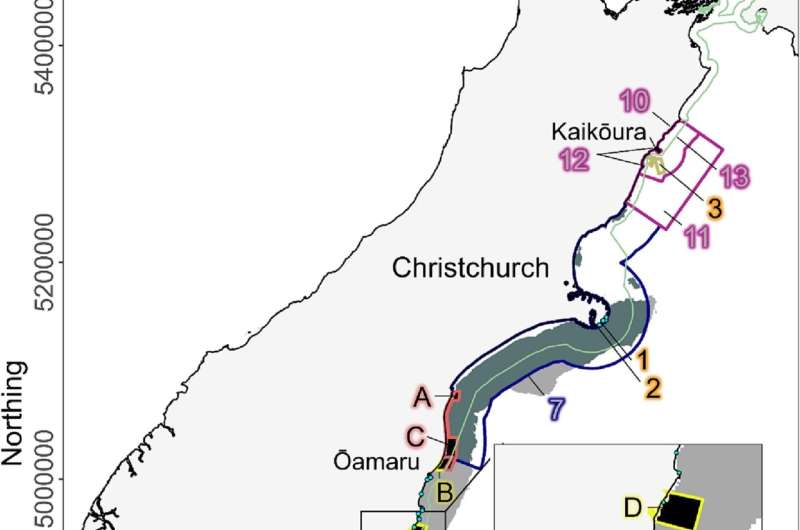This article has been reviewed according to Science X's editorial process and policies. Editors have highlighted the following attributes while ensuring the content's credibility:
fact-checked
peer-reviewed publication
trusted source
proofread
Understanding environment use key to protection of hoiho

Researchers hope a study into how hoiho (yellow-eyed penguin) foraging grounds overlap with commercial fisheries and marine protected areas will help better protect the unique penguin.
The paper, recently published in Biological Conservation, used GPS tracking to analyze hoiho distribution areas and found a high degree of overlap between the penguins and gillnet and trawl fisheries.
Lead author Dr. Rachel Hickcox, who completed her Ph.D. in the Department of Zoology, says understanding how penguins use their environment is "fundamental to determining how to protect them."
The researchers found hoiho forage mostly over the middle of the continental shelf where there is a high diversity of key prey species.
"However, less than 1% of the adult foraging distribution overlaps with current marine protected areas, and the proposed South-East Marine Protected Areas network would protect only 3.6% of their range," she says.
Another study by Otago Ph.D. candidate, Mel Young, also found a 26.4% overlap between commercial gillnet fisheries from 2017–19 and juvenile penguin foraging habitat.
The hoiho recovery strategy Te Kaweka Takohaka mō te hoiho highlights the need to reduce or eliminate the threat of bycatch and fisheries interactions and protect and support the marine habitat which hoiho depend on.
Research by Dr. Hickcox and other Otago students in recent years address some of these priorities and contribute to the wider conservation plan for hoiho.
"We now have a better understanding about the spatiotemporal interactions between hoiho and their environment. This information could be used in marine spatial planning, an ecosystem-based management approach to conservation.
"Moreover, it focuses on hoiho at sea, where they are currently facing a multitude of threats that past studies have indicated as primary reasons for their population decline," she says.
The goal of current research on hoiho is to provide better information to the people and organizations who are putting in considerable effort to protect this species from further population declines.
"However, this effort alone will not be enough without further conservation actions to protect them and their food resources as sea, especially because even the proposed SEMPA network will only protect a small area of their range," Dr. Hickcox says.
She hopes areas of high penguin-fisheries and/or penguin-prey overlap will be prioritized for future conservation efforts to mitigate the risks of bycatch, habitat destruction, and food scarcity.
She also believes alternative measures aside from marine protected areas should be considered. These could include voluntary or seasonal fishing restrictions, sustainable fisheries establishment, and compliance incentivizing.
"With the considerable amount of research being done on New Zealand marine fauna, there is a great opportunity to integrate analyses such as this into ongoing and future marine spatial planning to improve the national approach in New Zealand."
More information: Rachel P. Hickcox et al, Risks, resources, and refugia: Spatial overlap between yellow-eyed penguin foraging distribution and prey, commercial fisheries, and marine protected areas, Biological Conservation (2023). DOI: 10.1016/j.biocon.2023.110197
Journal information: Biological Conservation
Provided by University of Otago


















